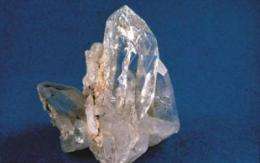Viscous cycle: Quartz key to tectonics

(PhysOrg.com) -- More than 40 years ago, pioneering tectonic geophysicist J. Tuzo Wilson published an article in the journal Nature describing how, over Earth’s long history, ocean basins opened and closed along North America’s eastern seaboard. His observations, dubbed “The Wilson Tectonic Cycle,” suggested this process had occurred many times; most recently causing giant Pangaea to split into today’s seven continents.
Wilson’s ideas were central to the so-called Plate Tectonic Revolution, the foundation for contemporary theories of processes underlying mountain-building and earthquakes. Since his 1967 article, additional studies have confirmed that large-scale deformation of continents repeatedly occurs in some regions but not others, though the reasons why remain poorly understood. New findings by Utah State University geophysicist Tony Lowry and colleague Marta Pérez-Gussinyé of Royal Holloway, University of London shed surprising light on these restless rock cycles.
“It all begins with quartz,” says Lowry, who published results of the team’s recent study in the March 17, 2011 issue of Nature. In “The Role of Crustal Quartz in Controlling Cordilleran Deformation,” the scientists describe a new approach to measuring properties of the deep crust that reveal quartz’s key role in initiating the churning chain of events that cause the Earth’s surface to crack, wrinkle, fold and stretch into mountains, plains and valleys.
“Earthquakes, mountain-building and other expressions of continental tectonics depend fundamentally on how rocks flow in response to stress,” says Lowry, assistant professor in USU’s Department of Geology and 2010 recipient of a National Science Foundation CAREER Award. “We know that all tectonics are a response to the effects of gravity, but we know less about rock flow properties and how they change from one location to another.”
Wilson’s theories provide an important clue, he says, as scientists have long observed that mountain belts and rift zones have formed again and again at the same locations over long periods of time.
But, why?
“Over the last few decades, we’ve learned that high temperatures, water and abundant quartz are all critical factors in making rocks flow more easily,” Lowry says. “But until now, we haven’t had the tools to measure these factors and answer long-standing questions.”
Since 2002, the NSF-funded Earthscope Transportable Array of seismic stations across the western United States has provided valuable remote sensing data about the continental crust’s rock properties.
“We’ve combined the Earthscope data with other geophysical measurements of gravity and surface heat flow in an entirely new way that allows us to separate out the effects of temperature, water and quartz in the crust,” Lowry says.
The Earthscope measurements have enabled the team to estimate the thickness, along with the seismic velocity ratio, of continental crust in the American West. Seismic velocity describes how quickly sound waves and shear waves travel through rock, he says, offering clues to its temperature and composition.
“By themselves, seismic velocities are sensitive to both temperature and rock type,” Lowry says. “But if the velocities are combined as a ratio, the temperature dependence drops out. We found that the velocity ratio was especially sensitive to quartz abundance.”
But even after separating out the effects of temperature, the scientists found that a low seismic velocity ratio, indicating weak, quartz-rich crust, systematically occurred in the same place as high lower-crustal temperatures modeled independently from surface heat flow.
“That was a surprise,” he says. “We think this indicates a feedback cycle, where quartz starts the ball rolling.”
If temperature and water are the same, Lowry says, rock flow will focus where the quartz is located because that’s the only weak link. Once the flow starts, the movement of rock carries heat with it and that efficient movement of heat raises temperatures, resulting in weakening of crust.
“On top of that, rock, when it warms up, is forced to release water that’s otherwise chemically bound in crystals,” he says.
Water further weakens the crust, which increasingly focuses the deformation in a specific area.
“If you’ve ever traveled westward from the Midwest’s Great Plains toward the Rocky Mountains, you may have wondered why the flat plains suddenly rise into steep peaks at a particular spot,” Lowry says. “It turns out that the crust beneath the plains has almost no quartz in it, whereas the Rockies are very quartz-rich. We think those belts of quartz could be the catalyst that sets the mountain-building rock cycle in motion.”
More information: “The Role of Crustal Quartz in Controlling Cordilleran Deformation,” Nature, 2011.
Provided by Utah State University


















